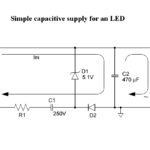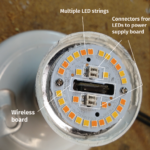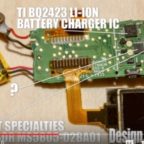Lithium batteries have a high energy density so they can store a lot of energy in a small volume. But they can go up in smoke when bad things happen. Recently we recorded a short video to show what can happen during one of those bad things – overcharging.
Excessive charging can bring on thermal run away in a lithium battery. Most lithium batteries contain special circuits to prevent this problem. Our video shows a few examples of these circuits. The two long, narrow circuit boards are typical of what you find inside a lithium power pack as might sit inside a laptop computer. The little pouch-type battery, which is from a toy, has one too. But for this demonstration we’ve removed the protective circuits.
For our test we connected a dc power supply across a lithium battery the same way as a battery charger would be connected. The maximum charge voltage for lithium cells is usually on the order of 4.5 V but we’ve got the dc supply cranked up much higher than that to show what happens with overcharging. Battery manufacturers also usually specify an optimum charging rate of no more than eight tenths of the rated current and of course we’re ignoring that as well.
Normally, Li-ion packs may see a total temperature rise of about 9ºF as they charge up. Keep that figure in mind as you watch our overcharging. We employed a spot thermometer to keep track of the battery temperature as things move along.
Our first battery was from a laptop computer battery pack. A point to note is that lithium batteries are not trickle charged when they reach full capacity like some other battery chemistries. That’s because doing so causes plating of metallic lithium in the battery. What happens with metallic plating is that high charge currents force lithium ions to accumulate at the surface of the anode without being absorbed into the anode itself. The plated-out lithium can eventually form short circuits between internal battery components.
And we sort of saw that with the laptop battery. The hottest spot on the battery, according to our spot thermometer, is near the anode.
Also with prolonged overcharging, the battery cathode material becomes unstable and produces carbon dioxide. The pressure inside the cell rises. Eventually the pressure rises enough to pop the battery casing at about 500 psi. At this point the cell vents and it may vent with flames.
In our experiment, our laptop battery got really hot and eventually vented. We didn’t get flames but we certainly got a lot of smoke.
Keep that venting in mind for our second battery, a small pouch battery that once powered a toy. Pouch batteries obviously don’t have metal cases like laptop batteries. So there’s no opportunity for a seal to break and release pressure when the battery heats up. With this little pouch battery we didn’t get a lengthy build up of carbon dioxide gas that happened in the laptop cell. This one went like a party popper in about a minute.
Our final test was of a somewhat bigger pouch battery which also came from a toy. This one took a bit longer to heat up and build up pressure. The reason for these big reactions is that lithium is highly reactive; it belongs to the alkali metal group.
When we overcharge the battery like this, we are causing a small fault or damage to the extremely thin separators that keep the elements of the battery apart. That is what leads to an internal short-circuit and a build-up of heat. Heat buildup in one cell can affect others in the nearby vicinity, which is why groups of cells in some electric vehicle battery packs are kept in separate protective compartments.
To summarize what appears in our little video, when you charge lithium batteries, don’t do what we did. Charge the battery at a moderate temperature, make sure the battery has a circuit that prevents overcharging, and stop charging if the battery heats up very much.







But does this say anything about how the batteries are best used in normal usage? Is it wiase to keep lithium based batteries on constant charge, like leaving the laptop constantly plugged into a power socket. This is common practice in most organisations now that laptops are used in preference to desktops.
It says zero about how batteries are normally used. We disconnected the circuitry normally found in lithium battery packs that prevents overcharging, to show what happens when something goes wrong.
In reply to Mike Chapman: the charge controllers in mobile phones and laptops make it safe to leave them permanently plugged-in. The only downside is that lithium ion cells live longer if charged to 40% – if charged to 100% their lifespans aren’t optimal. Lenovo allows you to set a charge level less than 100% to help preserve the battery.
What I’m keep to see is video of a lithium or lithium ion battery fire being extinguished by water, sand, or fire extinguisher. I know a little water can make a lithium fire worse, but my understanding is that lithium ion cells don’t have much elemental lithium in them, so sufficient water can reduce the temperature and smother the fire.
I hope this is just an experiment as lithium-ion batteries have an overcharge protection circuit.
As we explained in the video, we disabled the protection circuit so we could overcharge the batteries.
Most of the lithium battery contains overcharging prevention technique which will help to prevent from internal damage of the battery.
As we said in the article, we disabled the overcharge protection circuits to get the dramatic reactions we saw, which are designed to replicate what might happen if something goes wrong with the overcharge protection circuits, or if the battery is physically damaged.
I charged my 12.6v Li ion battery to 13.5 by mistake and it started to become hot so what I did is I started to discharge the battery until the rated voltage comes and I kept the battery in freezer to remove the heat from it ! Do I have to do any other measures to keep battery life longer
I have to manually balance my battery pack for my E-bike.
Essentially I bypass the BMS (Battery Management system)
And charge it one cell at a time.
The only protection I have is the charger having a maximum voltage,
The Statutator usually stops as well once voltage is reached. But the pack fell out of balance when storing one cell discharged faster then the rest. Eventually I’ll have to replace a few cells.